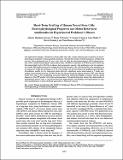Por favor, use este identificador para citar o enlazar a este item:
http://hdl.handle.net/10261/152112COMPARTIR / EXPORTAR:
 SHARE SHARE
 CORE
BASE CORE
BASE
|
|
| Visualizar otros formatos: MARC | Dublin Core | RDF | ORE | MODS | METS | DIDL | DATACITE | |

| Título: | Short-term grafting of human neural stem cells: Electrophysiological properties and motor behavioral amelioration in experimental Parkinson’s disease |
Autor: | Martínez-Serrano, Alberto CSIC ORCID; Pereira, Marta P. CSIC ORCID; Avaliani, Natalia; Nelke, Nelke; Kokaia, Merab; Ramos-Moreno, Tania CSIC ORCID | Palabras clave: | Ventral mesencephalon Electrophysiology A9-dopaminergic phenotype Human neural stem cells (hNSCs) Parkinson’s disease (PD) |
Fecha de publicación: | 17-jun-2016 | Editor: | Cognizant Communication Corporation | Citación: | Cell Transplantation 25: 2083- 2097 (2016) | Resumen: | Cell replacement therapy in Parkinson’s disease (PD) still lacks a study addressing the acquisition of electrophysiological properties of human grafted neural stem cells and their relation with the emergence of behavioral recovery after transplantation in the short term. Here we study the electrophysiological and biochemical profiles of two ventral mesencephalic human neural stem cell (NSC) clonal lines (C30-Bcl-X and C32-Bcl-X) that express high levels of Bcl-X to enhance their neurogenic capacity, after grafting in an in vitro parkinsonian model. Electrophysiological recordings show that the majority of the cells derived from the transplants are not mature at 6 weeks after grafting, but 6.7% of the studied cells showed mature electrophysiological profiles. Nevertheless, parallel in vivo behavioral studies showed a significant motor improvement at 7 weeks postgrafting in the animals receiving C30-Bcl-X, the cell line producing the highest amount of TH cells. Present results show that, at this postgrafting time point, behavioral amelioration highly correlates with the spatial dispersion of the TH grafted cells in the caudate putamen. The spatial dispersion, along with a high number of dopaminergic-derived cells, is crucial for behavioral improvements. Our findings have implications for long-term standardization of stem cell-based approaches in Parkinson’s disease. | URI: | http://hdl.handle.net/10261/152112 | DOI: | 10.3727/096368916X692069 | Identificadores: | doi: 10.3727/096368916X692069 issn: 0963-6897 |
| Aparece en las colecciones: | (CBM) Artículos |
Ficheros en este ítem:
| Fichero | Descripción | Tamaño | Formato | |
|---|---|---|---|---|
| Martínez-Serrano_Short-TermGraftingofHuman.pdf | 2,28 MB | Adobe PDF |  Visualizar/Abrir |
CORE Recommender
SCOPUSTM
Citations
2
checked on 22-abr-2024
WEB OF SCIENCETM
Citations
2
checked on 20-feb-2024
Page view(s)
279
checked on 24-abr-2024
Download(s)
286
checked on 24-abr-2024
Google ScholarTM
Check
Altmetric
Altmetric
NOTA: Los ítems de Digital.CSIC están protegidos por copyright, con todos los derechos reservados, a menos que se indique lo contrario.
